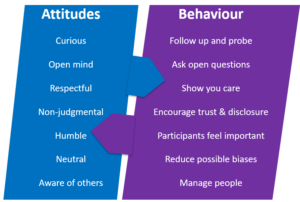Whether you are interviewing individuals or moderating groups, best practice is more than just asking questions. It’s a human to human interaction. You need to build trust, make the participants feel valued, encourage them to help you in your understanding. This is easier if you have the right mind set to start with.
Poor preparation brings the danger that you will get superficial answers, confirmation of your own ideas and biases, and bored, unhelpful respondents.
Starting with the right attitudes means that you almost automatically use good interviewing skills. And good skills feed back into useful attitudes.


Step 1 Objectives
Are you completely clear about the objectives? That the research will provide exactly the information you need to solve the problem?
YES – move on

Step 2 Method
What are the benefits and drawbacks of depth interviews or focus groups? What if you need to observe behaviour?
I know what method to use – go to 3

3 Minimise Bias
What expectations and biases might you have? What do you expect people to say, think, and do?
I am clear about my hypotheses and I do not judge people

4 Topic guide
Whether you are doing depths or groups you need to have a topic guide that manages the questions, research materials, people, and time.

5 Start well
A good opening to an interview or group sets you up for success. Plan it carefully to set up how people talk and interact. Motivate them to engage and help.

Step 6 Interview
Ask powerful questions without leading. Follow up interesting new information. Probe for better understanding, clarify meaning, deep dive. Listen perceptively but be non-judgmental.

7 Manage People
Manage people in Depth Interviews
- Easily build rapport
- Keep them involved
- Handle potentially difficult situations

8 Moderate
The secrets to moderating successful focus groups
Notice what goes on under the surface. Understand and manage group process and difficult situations in groups
Avoid common pitfalls

9 Stimulate
Use stimulus material and projective techniques for richer and deeper results.

Step 10 Analyse
Review your findings.
Discard anything that is irrelevant. Question any biases. Code, categorise – what does it all mean?
This section is being revised.
Having recently had the opportunity to take part in a qualitative training day focusing on moderating skills, hosted by Joanna at QualitativeMind, it’s fair to say I learnt a lot. The session started off with a quote:
“Interviewing is rather like a marriage: everybody knows what it is, an awful lot of people do it, and yet behind each closed door, there is a world of secrets.” (Oakley, 1981)
This certainly rang true as the day went on. There really are a lot of unknowns/secrets to interviewing and moderating; it’s not just about having a conversation. There is the role of the moderator, as well as each respondent and the group dynamics, to think about. So how can you ensure you are getting the most out of your focus group?
Manage your biases
As the moderator, you are the research instrument and need to manage your biases. The best thing to do is go into the group thinking you know nothing about the topic in-hand and the respondents will tell you everything you need to know.
Lay down the rules in your introduction
The introduction is the part of the focus group to primarily introduce yourself, your company, the purpose of the research, the Code of Conduct, the purpose of recording and health and safety, for example. However, this is also the time to lay down the rules. Clearly state your role is to ask questions, manage the time and move on if necessary. As the moderator you need to hold the power and refer back to what you stated in the introduction when time is running away with you, or even with a difficult respondent who won’t stop talking!
Focus your attention on the respondents
Attention on the respondents is key. Everyone craves attention (even in a focus group setting) – we’re only human after all! Acknowledge and value their emotions (this can be done by a simple nod). Try not to spend time in your head framing the next question, which is difficult but I’ve been assured practice will aid with this. Focus your complete attention on the respondents, even if you make a mistake they will still feel heard and valued.
Stay neutral
You need to stay as neutral as possible. This means you should avoid leading questions, offering your own opinions and giving examples. Again this is easier said than done but staying neutral will get the best results out of the group for your client.
Provide stimulus
The average attention span is 10-20 minutes. Not long is it? As well as changing topics, getting respondents to do things (not just talk about things) will help keep their attention. Stimulus can include mood boards, mapping exercises or drawings. However, a simple post-it note and getting respondents to write things down can prove just as effective. Changing the method of expression can really help with bringing quiet, disengaged respondents back into the group.
Although there is a lot to think about, the most important learning I took from this training was to be yourself and find the technique that suits you. Once you have understood the theory and the skills of interviewing and moderating, you can apply it. It just takes practice.
Blog by Lauren Harris, Research Assistant, Research by Design